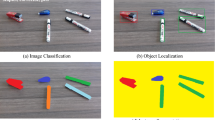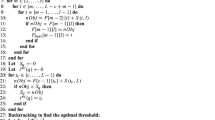Abstract
The level set method is a classical method to solve the Chan-Vese model for the binary image segmentation problem. Some efficient methods such as the convex relaxed methods and the steep descent methods based on a suitable constraint have been proposed to overcome the singularity of the LSM. However, the effectiveness of using these schemes is still limited by the chosen threshold value or the Courant-Friedrichs-Lewy condition. To this end, this paper, based on the Lagrangian dual scheme from the numerical optimization theory, proposes a novel numerical method to solve the CV model. Specifically, the binary constraint of the level set function can be transformed into a nonsmooth optimization problem via the help of the Lagrangian dual scheme. Then the Dual-based Alternating Direction of Method of Multipliers can be employed to solve this transform form. Numerical experiments show that the average (± std.dev) Segmentation Error (SE) of the proposed method on two groups of synthetic images are 5.59%(± 0.19%) and 5.01%(± 3.61%). The Precision, Segmentation Accuracy (SA) and F1-Score (F1S) of natural gray and natural color image reach 75.17%(± 12.42%), 98.87%(± 1.16%), 94.99%(± 5.23%) and 81.91%(± 14.85%), 98.38%(± 0.99%), 86.39%(± 11.72%), respectively, which are better than the other three comparison schemes. Therefore, our proposed method is more robust to initialization, faster and more accurate than three classical methods to solve the CV model.







Similar content being viewed by others
Notes
For convenience in the following, the variable x in the functions f(x) and ϕ(x) is omitted without any confusion.
p is a subgradient of a convex function g(x) at x0 ∈domg if g(x) − g(x0) ≥〈p,x −x0〉 for ∀x0 ∈domg.
References
Bae E, Yuan J, Tai X (2011) Global minimization for continuous multiphase partitioning problems using a dual approach. Int J Comput Vis 92 (1):112–129
Bauschke H, Combettes P (2011) Convex Analysis and Monotone Operator Theory in Hilbert Spaces, vol 408. Springer, Berlin
Bazaraa M, Sherali H, Shetty C (2006) Nonlinear Programming: Theory And Algorithms. Wiley, New York
Beck A (2014) Introduction to nonlinear optimization: theory, algorithms, and applications with MATLAB. SIAM
Biswas S, Hazra R (2020) A new binary level set model using L0 regularizer for image segmentation. Signal Process 174:107603
Boyd S, Parikh N, Chu E, Peleato B, Eckstein J (2011) Distributed optimization and statistical learning via the alternating direction method of multipliers. Found Trends Mach Learn 3(1):1–122
Cai Q, Liu H, Qian Y, Zhou S, Wang J, Yang Y (2022) A novel hybrid level set model for non-rigid object contour tracking. IEEE Trans Image Process 31:15–29
Casel K, Fernau H, Ghadikolaei K, Monnot J, Sikora F (2022) On the complexity of solution extension of optimization problems. Theor Comput Sci 904:48–65
Caselles V, Kimmel R, Sapiro G (1997) Geodesic active contours. Int J Comput Vis 22(1):61–79
Chambolle A, Pock T (2011) A first-order primal-dual algorithm for convex problems with applications to imaging. J Math Imaging Vision 40:120–145
Chan T, Esedoglu S, Nikolova M (2006) Algorithms for finding global minimizers of image segmentation and denoising models. SIAM J Appl Math 66 (5):1632–1648
Chan T, Vese L (2001) Active contours without edges. IEEE Trans Image Process 10(2):266–277
Courant R, Friedrichs K, Lewy H (1967) On the partial difference equations of mathematical physics. IBM J Res Dev 11(2):215–234
Gu Y, Wang L (2011) Efficient dual algorithms for image segmentation using TV-Allen-Cahn type models. Commun Comput Phys 9(4):859–877
http://www.wisdom.weizmann.ac.il/~vision/Seg_EvaluationDB/dl.html
Kadu A, Leeuwen T (2020) A convex formulation for Binary Tomography. IEEE Trans Comput Imaging 6:1–11
Kass M, Witkin A, Terzopoulos D (1988) Snakes Active contour models. Int J Comput Vis 1(4):321–331
Levine S, Pastor P, Krizhevsky A, Ibarz J, Quillen D (2017) Learning hand-eye coordination for robotic grasping with deep learning and large-scale data collection. Int J Robot Res 37:421–436
Li C, Kao C, Ding Z (2008) Minimization of region-scalable fitting energy for image segmentation. IEEE Trans Image Process 17(10):1940–1949
Li Y, Wu C, Duan Y (2020) The TVp regularized Mumford-Shah model for image labeling and segmentation. IEEE Trans Image Process 29:7061–7075
Li C, Xu C, Gui C, Fox M (2010) Distance regularized level set evolution and its application to image segmentation. IEEE Trans Image Process 19 (12):3243–3254
Lie J, Lysaker M, Tai X (2006) A binary level set model and some applications to Mumford-Shah image segmentation. IEEE Trans Image Process 15 (5):1171–1181
Martin C̆, Erich M, Matthias M, Nadejda F, Frederik M, Martin W, Dagmar G (2021) Comparison of segmentation algorithms for FIB-SEM tomography of porous polymers: importance of image contrast for machine learning segmentation. Microsc Microanal 110806:171
Martin L, Tsai Y (2020) Equivalent extensions of hamilton-jacobi-bellman equations on hypersurfaces. J Sci Comput 84:43
Morel J, Solimini S (1995) Progress in nonlinear differential equations and their applications. Birkhauser,
Mumford D, Shah J (1989) Optimal approximations by piecewise smooth functions and associated variational problems. Commun Pur Appl Math 42(5):577–685
Tu Z, Zhu S (2002) Image segmentation by data-driven Markov chain Monte Carlo. IEEE Trans Pattern Anal Mach Intell 24(5):657–637
Yang Y, Ren H, Hou X (2022) Level set framework based on local scalable Gaussian distribution and adaptive-scale operator for accurate image segmentation and correction. Signal Process 116153:104
Yang Y , Tian D, Jia W, Shu X, Wu B (2019) Split Bregman method based level set formulations for segmentation and correction with application to MR images and color images. Magn Reson Imaging 57:50–67
Yu H, He F, Pan Y (2020) A survey of level set method for image segmentation with intensity inhomogeneity. Multimed Tools Appl 79:28525–28549
Zaitouna N, Aqel M (2015) Survey on image segmentation techniques. Procedia Computer Science 65:797–806
Zhao M, Wang Q, Ning J, Muniru A, Shi Z (2021) A region fusion based split Bregman method for TV Denoising algorithm. Multimed Tools Appl 80:15875–15900
Acknowledgements
The authors also thank the anonymous referees for both the careful reading of their manuscript and the very helpful comments and suggestions.
Author information
Authors and Affiliations
Corresponding author
Ethics declarations
Conflict of Interests
The authors declared that they have no conflicts of interest to this work.
Additional information
Publisher’s note
Springer Nature remains neutral with regard to jurisdictional claims in published maps and institutional affiliations.
This work was partially supported by Science and Technology Major Project of Henan Province (No. 221100310200), Scientific and Technological Project in Henan Province (No. 212102210511) Natural Science Foundation of Henan province(No.232300420108) Natural Science Foundation of China (No. 12071345), Health Commission of Henan Province (No. Wjlx2020380), 2021 Henan Health Young and Middle-aged Discipline Leader Cultivation Project.
Rights and permissions
Springer Nature or its licensor (e.g. a society or other partner) holds exclusive rights to this article under a publishing agreement with the author(s) or other rightsholder(s); author self-archiving of the accepted manuscript version of this article is solely governed by the terms of such publishing agreement and applicable law.
About this article
Cite this article
Pang, ZF., Fan, LL. & Zhu, HH. A novel dual-based ADMM to the Chan-Vese model. Multimed Tools Appl 82, 40149–40166 (2023). https://doi.org/10.1007/s11042-023-14707-4
Received:
Revised:
Accepted:
Published:
Issue Date:
DOI: https://doi.org/10.1007/s11042-023-14707-4




